Key takeaways:
- Post-gig analysis is crucial for identifying performance strengths and weaknesses, enabling continuous improvement.
- Specific feedback, both technical and audience-related, is essential for enhancing future performances and fostering engagement.
- Adjusting equipment choices based on past experiences and audience feedback can significantly impact sound quality and overall performance.
- Collaborative approaches and setting targeted goals improve performance outcomes and help in addressing challenges effectively.
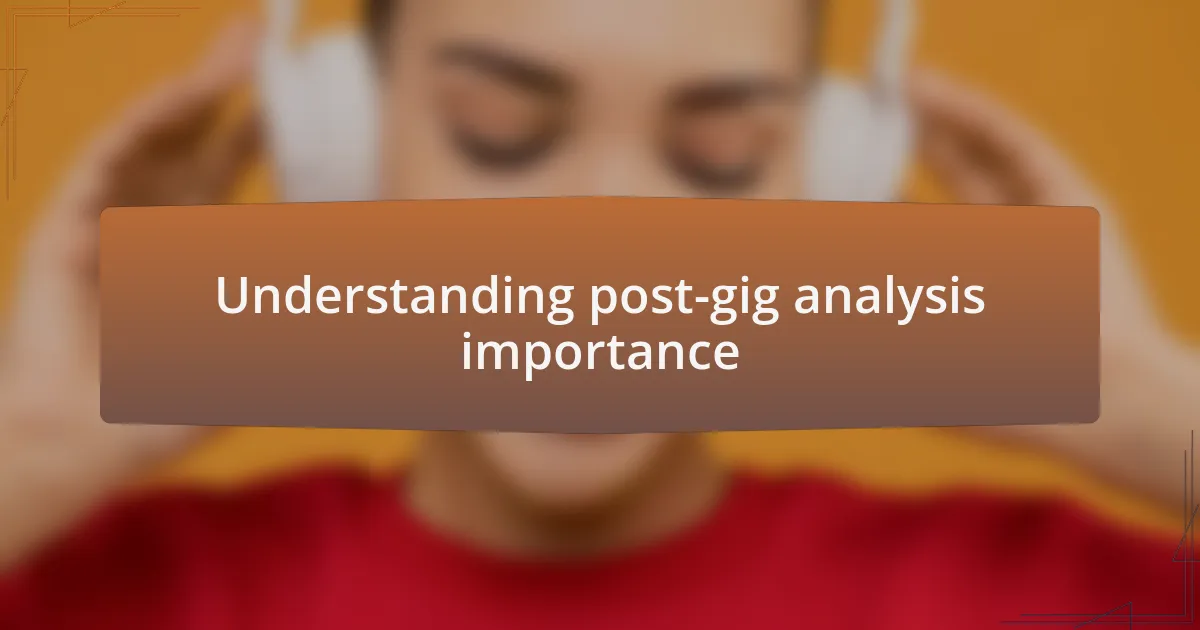
Understanding post-gig analysis importance
Post-gig analysis has become an essential part of my gig experiences, highlighting aspects I may overlook during the excitement of the live event. I remember sitting down after a particularly lively show, my adrenaline still pumping, and pausing to reflect. I realized that by critically assessing each performance—sound levels, crowd engagement, and even technical glitches—I could create a more solid foundation for future gigs.
Reflecting on challenges encountered during a gig, I often find that those moments offer the most valuable lessons. For instance, one time, a sudden equipment failure mid-show forced me to think on my feet. Analyzing that event afterward helped me understand the importance of backup plans and rehearsal protocols, allowing for a smoother experience next time.
It’s fascinating how post-gig analysis can lead to unexpected insights, don’t you think? I often question what I could have done differently, and this self-reflection pushes me to improve continuously. Ultimately, this process ensures that I’m not just moving through gigs mechanically, but evolving with each performance.
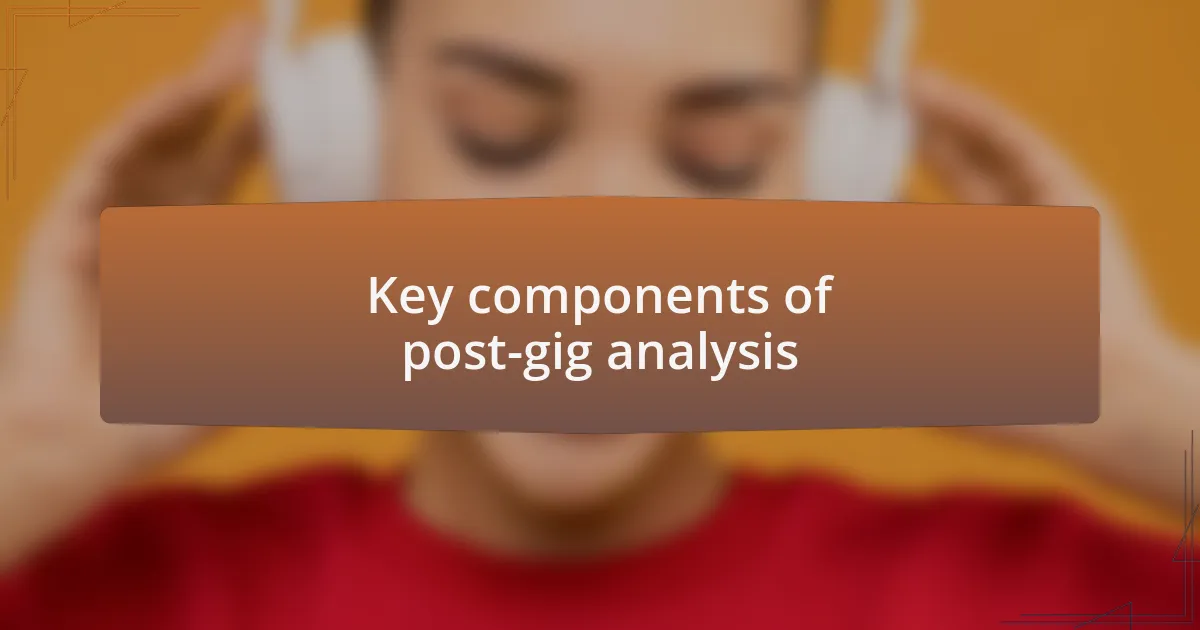
Key components of post-gig analysis
When I break down a performance during post-gig analysis, I pay close attention to the audio quality. There was a night I felt that the bass was overpowering. After reviewing the recordings, it became clear that a better equalization could enhance clarity. This kind of meticulous examination emphasizes that the smallest adjustments can significantly elevate the overall experience.
Technical feedback is another crucial component of my analysis. I remember a gig where the crowd seemed disengaged, and my initial thought was to blame external factors. Upon reviewing the show, I realized my transitions between songs lacked energy. This moment was an eye-opener for me, reinforcing the need to scrutinize not just technical elements but also performance dynamics.
Lastly, the audience’s reaction often serves as my best feedback loop. I recall a show where I engaged the crowd with a call-and-response segment, and their excitement filled the room. That energetic exchange reminded me how vital audience connection is. I often wonder: how can we foster that engagement in every performance? The answer lies in consistently analyzing these interactions to replicate and enhance them in the future.
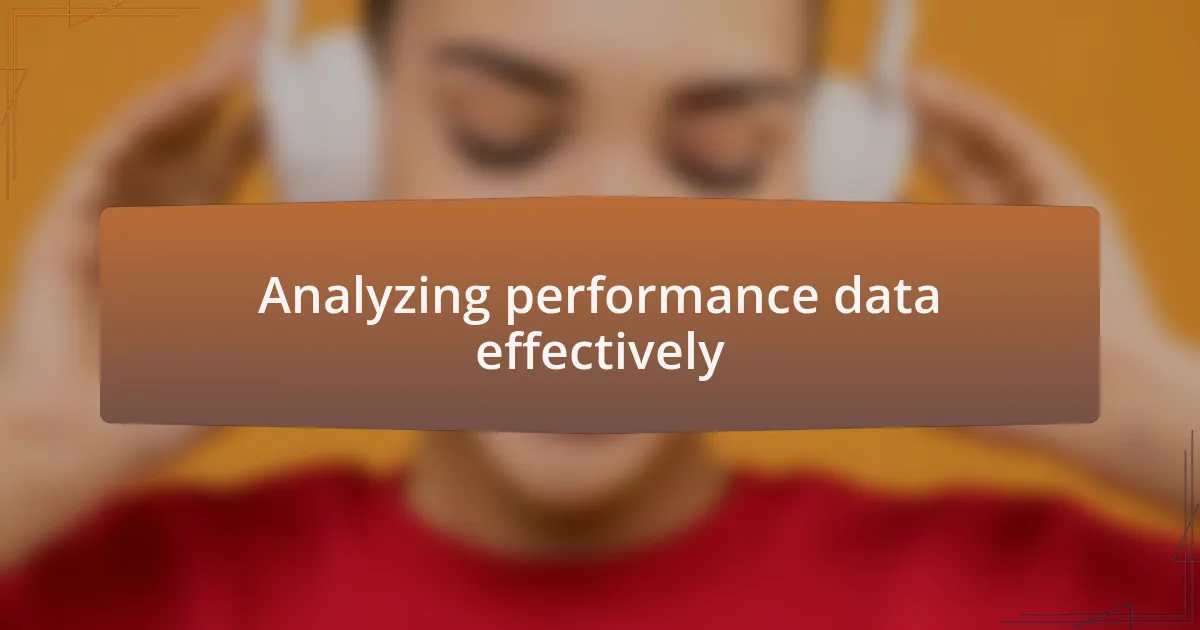
Analyzing performance data effectively
When tackling performance data, I focus on actionable insights. For instance, after a recent gig, I took a deep dive into the monitor reports. It surprised me to see that feedback levels were higher than I’d anticipated, leading me to adjust my setup for the next show. Isn’t it fascinating how these metrics can guide our future decisions?
I also pay close attention to audience engagement metrics, which can be revealing. I remember noticing a dip in the energy levels during a mid-set transition; tracking that data helped me realize I needed to rethink my pacing. Reflecting on those moments, I ask myself: how can I create a seamless flow that keeps the vibe alive?
In addition, using software to analyze sound is essential for pinpointing issues like distortion or unexpected drops in amplitude. I recall one performance where a specific frequency clash caused distortion—a simple adjustment in the mix next time made all the difference. By consistently analyzing this data, I turn small setbacks into stepping stones for improvement.
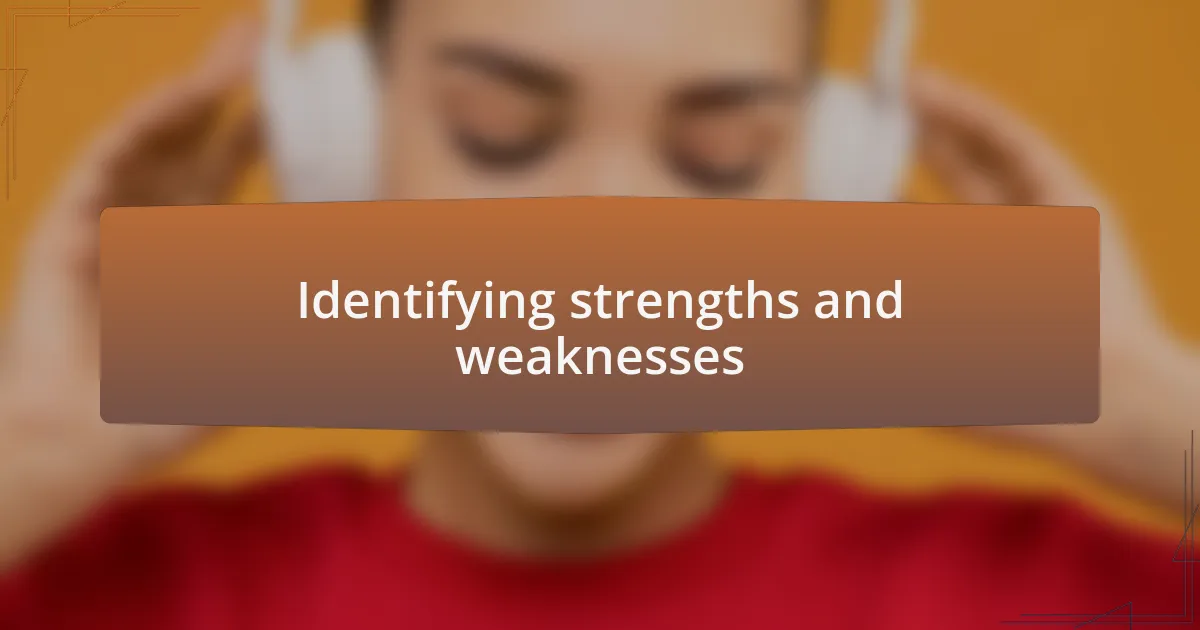
Identifying strengths and weaknesses
Looking back on my experiences, I’ve learned that identifying strengths and weaknesses requires a keen ear and an attentive eye. During one particular gig, I felt like the sound was spot on, but when reviewing the recordings later, I noticed how much more clarity I could have achieved in the high frequencies. It was a humbling moment that reminded me how crucial it is to assess every aspect of my performance.
Strengths often shine through in the energy of the crowd and the overall vibe. I remember a night when my choice of tracks had everyone moving; the set flowed seamlessly. However, in retrospect, I realized that I had relied too heavily on my go-to favorites instead of exploring new material. It’s moments like this that prompt me to ask: are we leaning into our comfort zones at the expense of growth?
Conversely, recognizing weaknesses can be uncomfortable but is invaluable for professional growth. After a show where feedback issues plagued me throughout, I felt deflated. Yet, reviewing the mic placements and gain settings showed me exactly where I erred. This process taught me that facing these challenges head-on doesn’t just strengthen my skills; it fosters resilience, pushing me to innovate and improve.
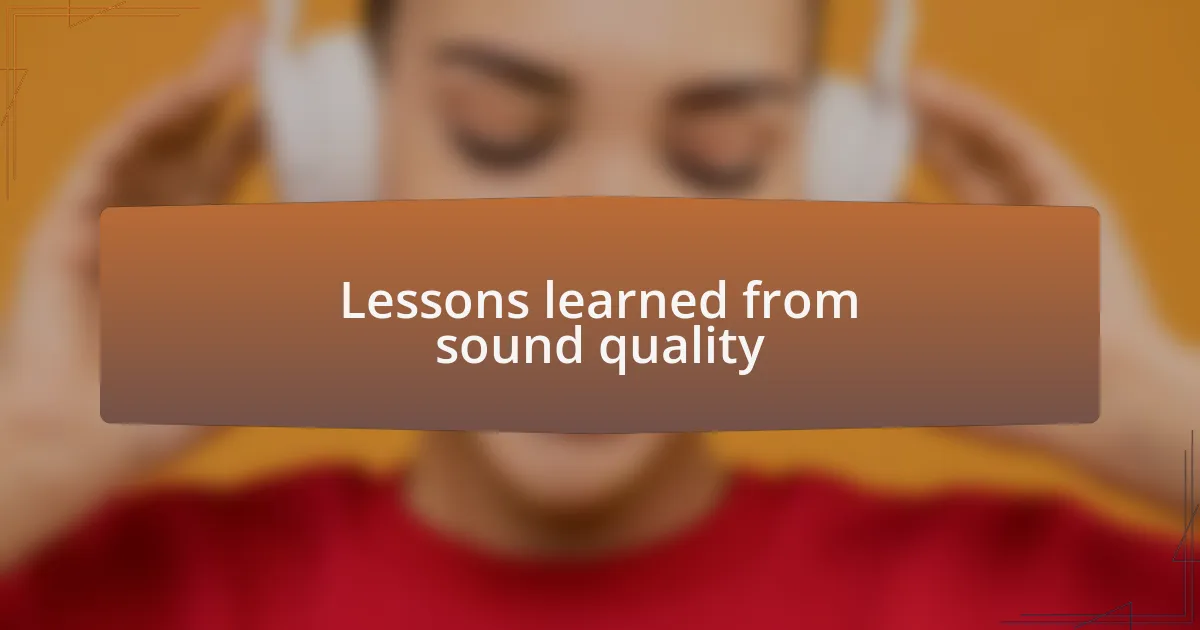
Lessons learned from sound quality
Evaluating sound quality has taught me that even the smallest details matter immensely. I once performed in a venue known for its challenging acoustics, and while I was proud of my set, the recordings revealed a muddiness that obscured my mixes. It made me wonder: how often do we overlook the importance of acoustical treatment before we even begin to play?
There was a night when my monitors were too quiet, making it hard to catch subtleties in the mix. The audience seemed to enjoy the performance, but upon re-listening to the recording, it was glaringly obvious that I lost some crispness in the vocals. I could feel the frustration welling up in me—had I prioritized volume over clarity? This experience left me questioning my sound check methods and the importance of ensuring that everything is balanced rather than just loud.
I’ve also learned the importance of meticulous EQ adjustments. I remember a gig where I tweaked my settings, only to discover that a harsh frequency was veiling the warmth I aimed for. It was a learning moment; I realized that trusting my intuition while still being critical can lead to a richer sound experience. Have I considered how much potential lies in fine-tuning instead of resorting to broad strokes? These moments make me continually strive for better sound quality in every performance.
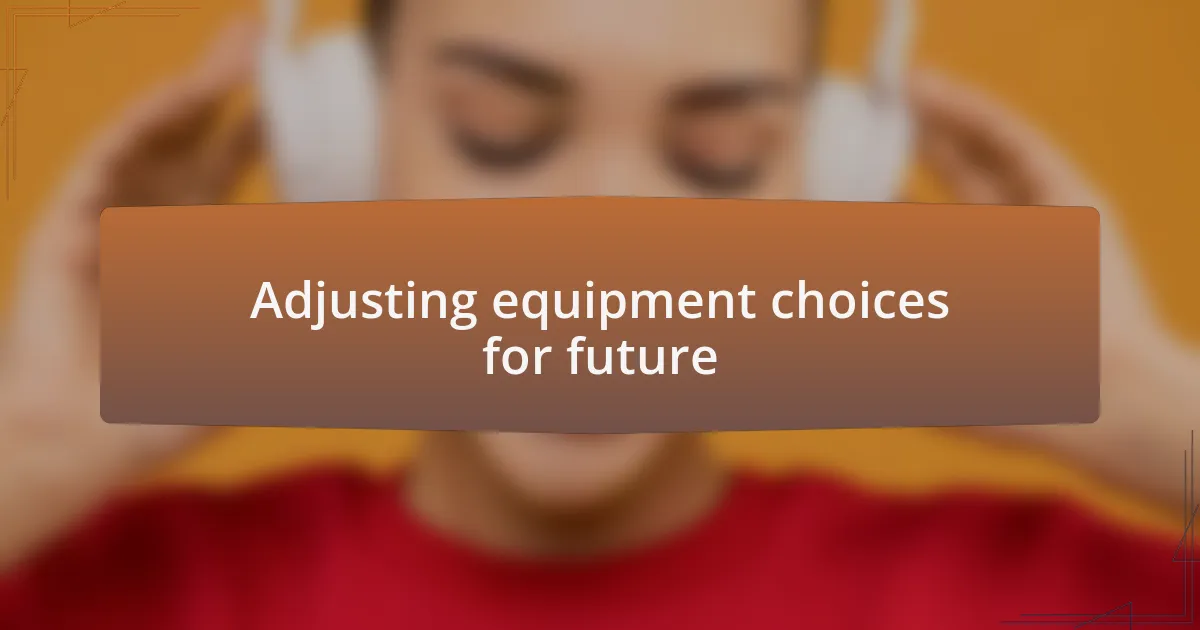
Adjusting equipment choices for future
When approaching future gigs, I’ve found that reevaluating my equipment choices is crucial. After realizing that my stereo setup didn’t translate well in certain venues, I started considering alternatives that offer more versatility. For instance, switching to a more portable system with adjustable components not only lightened my load but also allowed me to adapt quickly to different acoustics. Isn’t it fascinating how a simple change can enhance your performance?
One gig stands out in my memory; I used a new microphone that I thought would elevate the vocals. Instead, it ended up picking up excessive background noise, overshadowing the nuances of my performance. This taught me that choosing the right gear isn’t just about brand names or price tags; it’s about selecting tools that genuinely match the environment and the sound I want to create. Have I spent enough time researching gear that aligns with my artistic intent?
Feedback from previous performances has become a goldmine for adjusting equipment choices. I remember a time when I received rave reviews about my use of in-ear monitors, which made me reconsider my previous preference for floor wedges. Listening to the audience’s experience and my own has encouraged me to continuously update my gear based on genuine performance needs. Could it be that the best insights often come from those moments when things don’t go perfectly as planned?
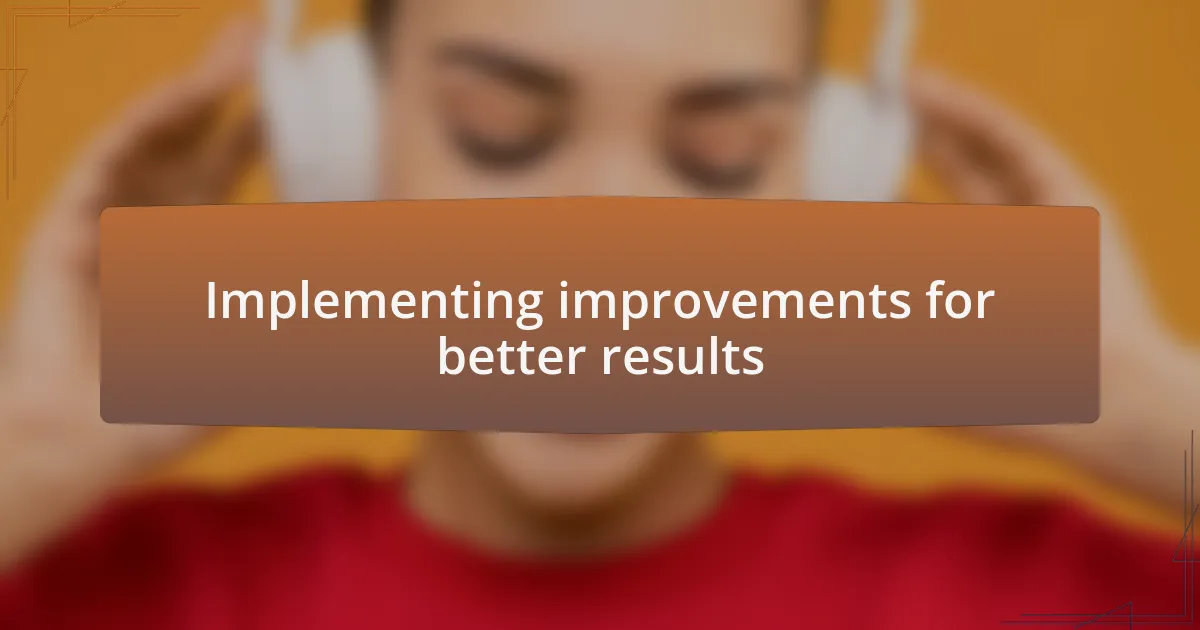
Implementing improvements for better results
Recognizing that post-gig analysis is a catalyst for improvement, I’ve taken to heart the importance of reviewing not just my equipment, but my entire approach. During one particular show, I found myself struggling with sound feedback during my performance. Reflecting on that, I implemented a better soundcheck protocol, ensuring each venue’s acoustics were accounted for. Could taking just a few extra moments to assess the space truly make that much of a difference? Absolutely—it can transform a good performance into a great one.
As I look back, I’ve realized that incorporating team feedback has been a game changer. After a gig where my sound engineer pointed out the mix could have been clearer, I began to engage them more in the planning process. Their perspective provided insights I hadn’t considered, revealing how a collaborative approach can refine our results. Have I really been tapping into the full potential of my team’s expertise? The answer has become a resounding yes—sharing knowledge often results in collective growth.
Moreover, I’ve started setting specific goals for each performance based on past experiences. After struggling with pacing during an energetic set, I committed to rehearsing my transitions more rigorously. This adjustment not only enhanced the flow of my shows but also heightened my confidence on stage. Isn’t it motivating to see how targeted improvements can yield impressive results? Embracing such focused strategies makes the journey rewarding and exciting.